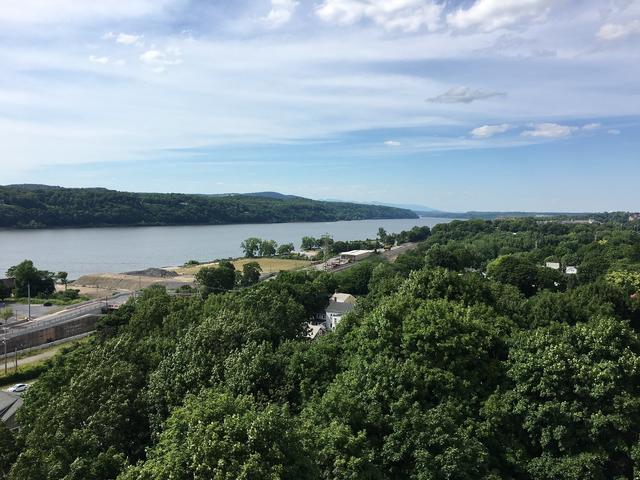Home » Regions » North America » Eastern Temperate Forests » Mixed Wood Plains » Northeastern Coastal Zone » Hudson Valley
Hudson Valley
Last updated: December 11th, 2020
Page contents
↑About the Hudson Valley
The Hudson Valley is a large valley located entirely within the eastern portion of New York State, a bit north from New York City. The region has a complex geologic history. It is part of the Great Appalachian Valley and can be seen as a northerly extension of the limestone and shale valleys of the Ridge and Valley region, but unlike most of those valleys, which run perpendicular to major rivers, the Hudson valley is also a major river valley, and much of it was recently covered by a glacial lake. The Hudson river is an estuary, with some tidal influence extending as far north as Troy.The terrain here consists of a broad, irregular valley, with some plains, broken up by hills and terraces; the region is flattest in the glacial lake plain in the north of the region, and there is also a narrow floodplain along the Hudson river. The underlying bedrock is mostly shale and siltstone, which were more easily eroded than the metamorphic rocks and sandstone-capped shale of bordering regions. In the most recent glacial period, however, a large lake, called Glacial Lake Albany, formed in this region. This caused sediment to accumulate here, which now covers the valley floor. Soils are diverse in both texture and nutrient levels, ranging from excessively-drained sands of glacial origins to more nutrient-rich soils, as well as more nutrient-poor loams.
This region has a mix of forest types on different sites. At lower elevations, Appalachian oak-hickory forests can be found, with some species reaching their northern limits here. Dominant species are black oak (Quercus velutina), white oak (Quercus alba), pignut hickory (Carya glabra), mockernut hickory (Carya tomentosa), and shagbark hickory (Carya ovata). Around Albany, coarse-grained sands create a more barren, fire-prone area called the Pine Bush, in which pitch pine (Pinus rigida) and bear oak (Quercus ilicifolia) are dominant. More upland parts of this valley, especially in the north, are dominated by northern hardwood forests with American beech (Fagus grandifolia), sugar maple (Acer saccharum), and yellow birch (Betula alleghaniensis) as dominant trees.
This area is heavily utilized for agriculture, and also has significant urban development, contrasting with the more forested, rocky upland areas it borders. However, there is also still significant forest cover, mostly on the steeper terrain. There are also still barrens on the areas with coarse, sandy soil, including some protected land at Albany Pine Bush Preserve and Wilton Preserve. Climate change is leading the Appalachian oak-hickory forests to gradually expand into areas formerly occupied by northern hardwood forests.
This region borders many different regions. At its southern end it is bordered to the south by the Glaciated Reading Prong/Hudson Highlands, a rugged upland area, and to the southwest by the Northern Glaciated Shale and Slate Valleys as well as a tiny border with the Northern Glaciated Limestone Ridges, Valleys, and Terraces, which together represent the end of the Ridge and Valley region of the Appalachians. To the east it is bordered along its entire length by the Taconic Foothills. North of the Ridge and Valley system, it is bordered to the west by the Catskills Transition, and north of that, by the Glaciated Low Allegheny Plateau, and even farther north of that, by the Mohawk Valley. The north end of the region is bordered to the northwest by the Eastern Adirondack Foothills, and in a small area directly to the north by the Champlain Lowlands.
 This view, from the Walkway Over The Hudson near Poughkeepsie, NY, shows the hilly, forested scenery of the Hudson Valley, in the area directly adjacent to the river.. Photo © jschauma (Flickr), CC BY 2.0.
This view, from the Walkway Over The Hudson near Poughkeepsie, NY, shows the hilly, forested scenery of the Hudson Valley, in the area directly adjacent to the river.. Photo © jschauma (Flickr), CC BY 2.0.Plant Lists & In-Region Search
We do not yet have data to generate plant lists for a region as fine-tuned as this one. However you can move up to the broader Northeastern Coastal Zone and generate lists for that region: native plants or all plants. Or search that region's plants here:
↑References
1. Bryce, S.A., Griffith, G.E., Omernik, J.M., Edinger, G., Indrick, S., Vargas, O., and Carlson, D. "Ecoregions of New York (Poster)", U.S. Geological Survey (2010) Web.


